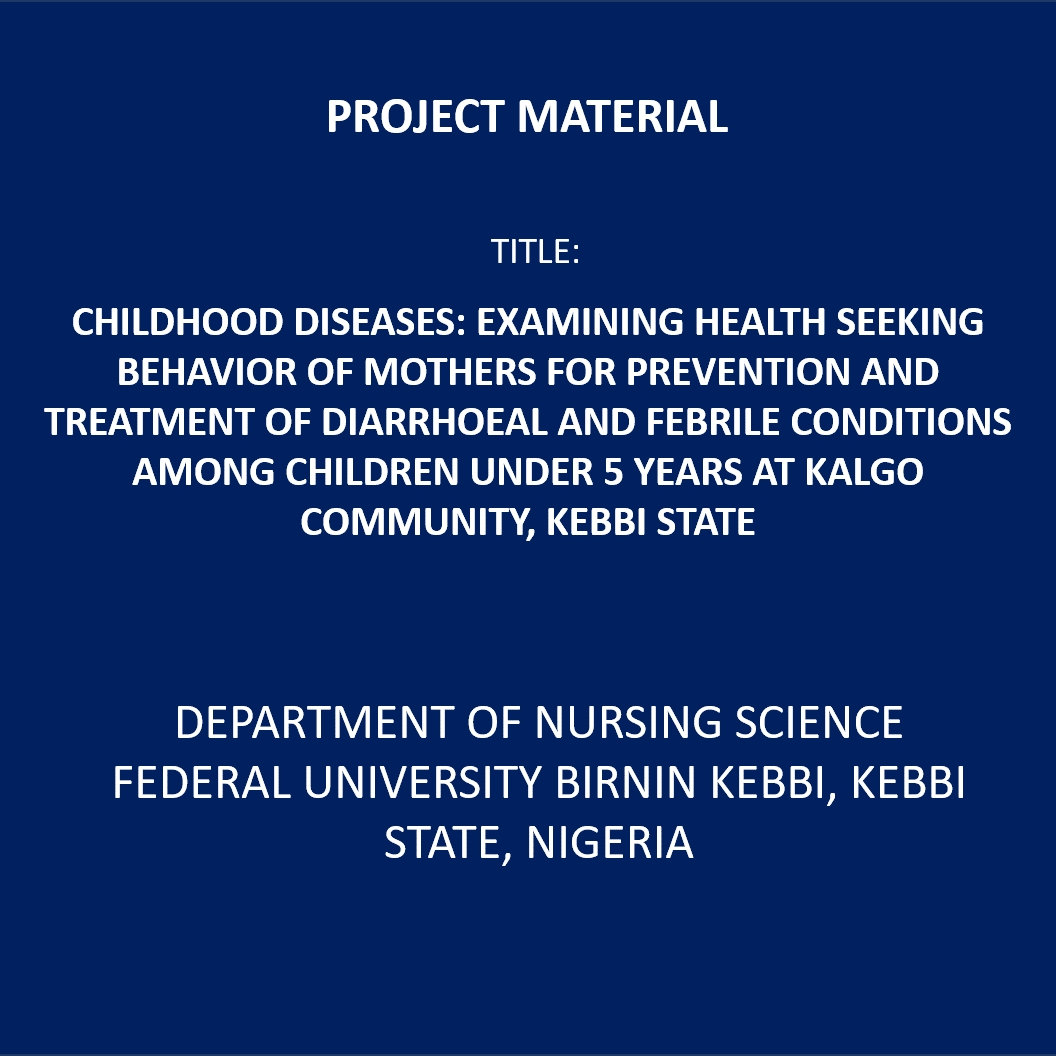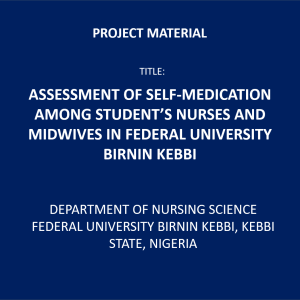No products in the cart.
Childhood Diseases: Examining Health Seeking Behavior of Mothers for Prevention and Treatment of Diarrhea and Febrile Conditions Among Children Under 5 Years at Kalgo Community, Kebbi state.
₦10,150.00
This study was primarily aimed to assess the health care seeking behavior of mothers on the prevention and treatment of febrile conditions and diarrhea disease of under 5 years children in Kalgo community.
BACKGROUND OF THE STUDY
Childhood diseases are a major public health problem in many parts of the world. Diarrhea and fever are two of the leading causes of illness and death among children under five years of age. Although, the safest and most effective interventions for childhood illnesses prompt treatment of the disease, prevention is also important and these can only be achieved through adequate health behavior among mothers. Despite available, inexpensive and effective treatments, febrile conditions and diarrhea still contribute the majority of the global burden of childhood morbidity and mortality.
Children are dying because care-seeking for childhood illnesses was suboptimal (Adeoti & Cavallaro, 2022). Another reason is that services are provided piecemeal and those most at risk are not being reached. For instance, children are not receiving life-saving treatment, and only 35% of children with diarrhea receive oral rehydration therapy (United Nation International Children Emergency Fund [UNICEF], 2013).
Diarrhea is defined as having loose or watery stools at least three times a day, or increased frequency of stool as reported by the mother (World Health Organization) [WHO], 2014).Febrile conditions are those illnesses or medical situations involving fever and their effects. Examples of such illnesses include malaria, pneumonia. Although most childhood febrile conditions and diarrhea episodes are mild, acute cases can lead to loss of consciousness, death or other severe consequences as a result of elevated temperature, severe fluid loss and dehydration (WHO, 2014).
Globally, childhood diarrhea is among the main killers of children under the age of 5 years (UNIFEF, 2019). In 2015, 9% of deaths of children under age 5 years are caused by diarrhea disease alone (UNICEF, 2019). Most of child deaths from diarrhea occur in the low-income regions of the world in which nearly 90% of the deaths occur in sub-Saharan Africa and South Asia (UNICEF, 2013). As a result, child hood diarrhea has long been regarded as a disease of poverty because it is mainly associated with factors such as, low health seeking behaviours, under nutrition and lack of access to essential services such as toilets and clean water (UNICEF, 2013).
United Nations Children’s Fund (UNICEF) recommended combination of oral rehydration salts (ORS) and zinc supplementation can reduce the severity of diarrhea while preventing relapse and dehydration (UNICEF, 2013). Coverage of zinc supplementation for diarrhea treatment is particularly low because introduction and scale-up in most low- and middle-income countries has only occurred recently (UNICEF, 2019).
Deaths due to these diseases are largely preventable through optimal health seeking behaviors and practices which includes adequate nutrition, vaccinations, hand washing, safe drinking water and basic sanitation, among other measures (Adeoti & Cavallaro, 2022).
Since 1990, Nigeria has shown a remarkable reduction in under five mortality and the country is one of the few countries that has achieved the millennium development goal 4 (MDG 4) of reducing child deaths by two thirds (Initiative Clinton Health Access [ICHA], 2013). Ending preventable childhood deaths and consequences is possible through proven cost-effective preventive and curative interventions and does not demand advanced technology. Unfortunately, there is a gap in coverage of relevant and effective interventions and has not yet reached the levels required for the desired impact. Improvements in drinking water, sanitation and hygiene are reducing diarrheal infections, and the use of treated mosquito nets are reducing febrile conditions due to malaria parasite but only two in five children in the world get appropriate treatment when they fall ill (UNICEF, 2019).
Through the support from UNICEF and other partners, the government of Nigeria has also been working to strengthen the integrated community case management (ICCM) of diarrhea, malaria and pneumonia. Yet, coverage of these treatments is unacceptably low only 2% and 26% of children receive zinc and ORS, respectively. In general, delayed treatment-seeking behavior and low utilization of health services are key bottlenecks to treating children under five (IHCA, 2013). Improving access to treatment for diarrhea can help dramatically reduce under 5 years deaths in Nigeria. Improving and optimizing care seeking behaviors and thereby increasing utilization of ICCM and IMNCI treatment services for pneumonia and diarrhea (IHCA, 2013).
In recent past, most malaria endemic areas have used fever as a proxy for malaria even though the cause could be different (UNICEF, 2015). Childhood fever is the common clinical sign of P.falciparum infection (UNICEF, 2019). However, Malaria, pneumonia and diarrhea are responsible for most of the morbidity and mortality in under-5 year old children worldwide, and accounts for approximately 3.6 million deaths annually (UNICEF, 2013). Of these three causes, malaria and pneumonia have remained as the leading causes of morbidity and mortality in children under the age of five in sub-Saharan Africa (UNICEF, 2015).
A large proportion of fever and diarrhea cases are treated outside the formal health care system (IHCA, 2013). Because many rural areas have limited resources, health facilities are not easily accessible to much of the population (Management Science for Health [MSH], 2016), and as such most sick children end up being treated through the informal sector, including community health workers, drug sellers, and traditional healers (WHO, 2018). This inadequacy of health care facilities, coupled with lack of skilled health care workers greatly impacts the treatment of many childhood illnesses and contributes to childhood morbidity and mortality.

